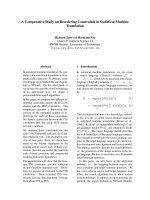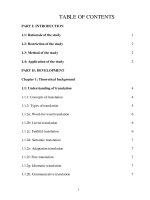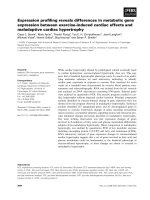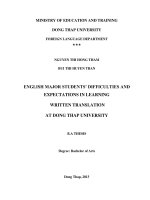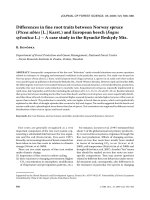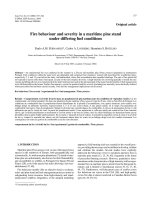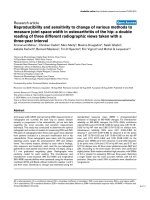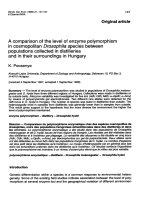A study on similarities and differences in current affairs translation between broadcasting and printing newspapers
Bạn đang xem bản rút gọn của tài liệu. Xem và tải ngay bản đầy đủ của tài liệu tại đây (273.32 KB, 42 trang )
1
TABLE OF CONTENTS
PART I: INTRODUCTION
1.1: Rationale of the study
1
1.2: Restriction of the study
2
1.3: Method of the study
2
1.4: Application of the study
2
PART II: DEVELOPMENT
Chapter 1: Theoretical background
1.1: Understanding of translation
4
1.1.1: Concepts of translation
4
1.1.2: Types of translation
5
1.1.2a: Word-for-word translation
6
1.1.2b: Literal translation
6
1.1.2c: Faithful translation
6
1.1.2d: Semantic translation
7
1.1.2e: Adaptation translation
7
1.1.2f: Free translation
7
1.1.2g: Idiomatic translation
7
1.1.2h: Communicative translation
7
2
1.2: Features of current affairs from language to structure
8
1.2.1: Language
8
1.2.2: Structure
9
1.3: Broadcasting and printing newspapers
9
1.3.1: Understanding of Broadcasting and printing newspapers
9
1.3.1a: Broadcasting
9
1.3.1b: Printing newspapers
10
1.3.2: Similarities between Broadcasting and Printing Newspapers
11
1.3.3: Differences between Broadcasting and Printing Newspapers
11
1.3.3a: Practical differences
11
1.3.3b: Historical differences
13
1.3.3c: Regulatory differences
14
Chapter 2: Similarities and differences in Vietnamese-English translation
between broadcasting current affairs and printing newspaper current affairs
2.2.1: Similarities in Vietnamese-English current affairs translation
between broadcasting and printing newspapers
2.2.1a: Short paragraph format
16
2.2.1b: Expanded simple sentences are commonly used in current affairs
translation
20
2.2.2: Differences in Vietnamese-English translation between
broadcast current affairs and printing newspapers current affairs
3
2.2.2a: Differences in Vietnamese-English translation between the lead of
broadcasting current affairs and the lead of printing newspaper current affairs
22
2.2.2a1: Differences in the use of tenses
22
2.2.2a2: Differences in complexity of sentence structures
25
2.2.2a3: Differences in the information density
26
2.2.2b: Differences in Vietnamese-English translation between main paragraphs
of broadcasting current affairs and printing newspaper current affairs
29
2.2.2b1: Difference in the length
29
2.2.2b2: Differences in the positions of quotation sources
31
2.2.2b2: Differences in the positions of quotation sources
32
Chapter 3: Findings
3.1: Lead reduction and lead expansion
PART III: CONCLUSION
3.1: Conclusion
36
3.2: Suggestion for further study
37
3.3: References
38
4
PART I: INTRODUCTION
1.1: Rationale of the study
In the pace of global rapid development, broadcasting and newspapers
have grown continuously from rudimentary simple forms at the beginning to
sophisticated modern ones at the present and played an important role in that
development. With a range of news, articles, events involving daily stories or
great inventions … all are transmitted to all over the world. However, each
nation owns a significant culture, particularly a specific language, so how to
convey successfully contents by broadcasting and newspapers is not easy
completely. Actually, the function of language translation is clearly expressed in
all fields. So, though you are a foreigner, you catch the meaning of news
transmitted by the language bridge - English. All nations are easier to exchange
information and get closer each other.
To realize the importance of English in the process of international
integration, more and more foreign-language universities in Viet Nam are
established to produce the human resources in language translation field in
general and those in broadcasting and newspapers translation in particular to
meet the demand of national development. Because the knowledge is unlimited,
time frame of studying translation subject is limited. Therefore, it is necessary
that each student has to study, enhance the professional knowledge, keep
enthusiasm and make them become the good quality of a translator in the fields,
especially news translation in broadcasting and newspapers.
After deciding to study one foreign-language (English), I hope that
someday I would become a sports editor working for the Hai Phong
Broadcasting and Television Station. However, there is a lack of knowledge,
experience as well as, it is unavoidable for me to make mistakes in the theme-
run process. But I believe that I will enrich much more experiences of translating
5
broadcasting and newspapers news in general and sports news in particular after
my theme is completed successfully. It will help me more self-confident to keep
my future job.
1.2: Restriction of the study
There are quite several sources that I can pick up important and necessary
information for my study. So, this paper graduation is mainly studied in the
research of the VOV and the VNS. Generally, they are two sources available and
helpful.
1.3: Method of the study
There were useful consultations from my supervisor helping me get over
so lot of difficulties in working out paper graduation.
The data analyzed in the present study was composed of translated
English current affairs reports and their corresponding Vietnamese originals
retrieved from the websites of the VOV and the VNS. I first scanned English
current affairs dated from January to May, 2009 and for those identifiable as
translations I tracked down their originals by searching the Vietnamese website.
I then compared the two texts for shifts.
1.4: Application of the study
This study can be used as reference documents in broadcasting and print
media translation. It will give students interested in broadcast and print media a
practical help to settle information transmitted in the most effective way.
1.5: Design of the study
The organization of the study is a composition of three main parts
Part1: Introduction represents the rationale, the restriction, the method, the
application and the design.
6
Part 2: Development focuses the main content of the study and is divided into
three chapters.
Chapter 1: Theoretical background.
Chapter 2: Similarities and differences in Vietnamese-English translation
between broadcasting current affairs and printing newspaper current affairs
Chapter 3: Findings
Part 3: Conclusion gives a brief summary of the study and suggestions for the
study.
7
PART II: DEVELOPMENT
CHAPTER 1: THEORETICAL BACKGROUND
1.1: Understanding of translation.
1.1.1: Concepts of translation.
Translation typically has been used to transfer from written or spoken SL
(source language) texts to equivalent written or spoken TL (target language)
texts. In general, the purpose of translation is to reproduce various kinds of texts
including religious, literary, scientific, and philosophical texts in another
language and thus making them available to wider readers.
If language was just a classification for a set of general or universal
concepts, it would be easy to translate from a SL to a TL. Furthermore, under the
circumstances the process of learning a language would be much easier than it is
actually. In this regard, Culler (1976) believes that languages are not
nomenclatures and the concepts of one language may differ radically from those
of another, since each language articulates or organizes the world differently,
and languages do not simply name categories; they articulate their own. The
conclusion likely to be drawn from what Culler (1976) wrote is that one of the
troublesome problems of translation is the disparity among languages. The
bigger the gap between the SL and the TL, the more difficult the transfer of
message from the former to the latter will be. Therefore, there are various
concepts of translation basing on the individual views. And I have collected and
studied some of them.
1.1.1a: Translation is the replacement of text material in one language by
equivalent textual material in another language.
(Cartford, 1965:20)
8
1.1.1b: Translation consists of reproducing in the receptor language the closest
natural equivalent of the source language message, firstly in term of meaning
and secondly in terms of style.
(Nida and Taber, 1969)
1.1.1c: Translation is the process of finding a target language (TL) equivalent
from a source language (SL) utterance.
(Pinhhuck, 1977:38)
1.1.1d: Translation involves the rendering of a SL text into the TL so as to ensure
that surface meaning of the two will be approximately similar and the structure
will be seriously distorted.
(Mc Guire, 1980:2)
1.1.1e: Translation is a craft consisting in the attempt to replace a written
message and/or statement in one language by the same message and/or statement
in another language.
(Newmark, 1981:7)
1.1.1f: Translation is the transfer process which aims at the transformation of a
written SL text into an optimally equivalent TL text, and which requires the
syntactic, the semantic and the pragmatic understanding and analytical
processing of the SL.
(Will in Noss, 1983)
Generally, translation is converting one language (SL) to another (TL) so
that the TL could convey the intended message in SL. In other words, it is a
process through which the translator decodes SL and encodes his understanding
of the TL form.
1.1.2: Types of translation.
9
There is a considerable variation in the types of translations produced by
translators. Some work only in two languages and are competent in both. Others
work from their first language to their second language, and still others from
their second language to their first language. Depending on these matters of
language proficiency, the procedures used will vary from project to project. In
most projects in which SL is involved, a translation team carries on the project.
Team roles are worked out according to the individual skills of team members.
There is also some variation depending on the purpose of a given translation and
the type of translation that will be accepted by the intended audiences.
According to Peter Newmark, there are 8 methods of translation on which a
professional translator can rely.
1.1.2a: Word-for-word translation.
In this kind of translation, TL is often right below the SL words. The SL
word-order is preserved as precisely as possible and the words are translated
word-by-word by their most common meanings regardless of the context.
Culture words are translated literally. The main use of word-for-word translation
is either to understand the structures of the SL or to analyze a difficult and
complex text as a pre-translation process.
He was presented by his director.
Anh Êy ®-îc trao th-ëng bëi gi¸m ®èc cña anh Êy
1.1.2b: Literal translation.
The SL grammatical structures are converted to their nearest TL
equivalences but the lexical words are again translated word-by-word regardless
of the context
1.1.2c: Faithful translation.
10
A faithful translation is used when translators want to reproduce the
precise contextual meaning of the SL within the restriction of the TL
grammatical structures. It converts cultural words but reserves the degree of
grammatical and lexical ‚abnormality‛ in the translation. It attempts to be
completely faithful to the intentions and text-realization of the SL writer.
1.1.2d: Semantic translation.
Semantic translation is closer, more literal; it gives highest priority to the
meaning and form of the original, and is appropriate to translations of source
texts that have high status, such as religious texts, legal texts, literature, and
perhaps ministerial speeches
1.1.2e: Adaptation translation.
This seems to be the freest form of translation. It is used mainly for plays
and poetry in which the themes, characters and plots are usually preserved, the
SL culture converted to the TL culture and text rewritten.
1.1.2f: Free translation.
This reproduces the matter without the manner, or the content without the
form of the original. Usually it is a paraphrase much longer than the original, a
so-called ‚intralingua translation‛.
1.1.2g: Idiomatic translation.
Idiomatic translation reproduces the content of the original but tends to
distort nuances of meaning by borrowing colloquialism and idioms where these
do not exist in the original.
A penny saved is a penny gained
TÝch tiÓu thµnh ®¹i
1.1.2h: Communicative translation.
11
The difference mainly between two methods of semantic and
communicative translation is that the semantic form adheres more to literal
translation while the communicative strategy is more concerned with the overall
sense of the text.
Communicative translation is freer, and gives priority to the effectiveness
of the message to be communicated. It focuses on factors such as readability and
naturalness, and is appropriate to translations of pragmatic texts where the actual
form of the original is not closely bound to its intended meaning. These are texts
like advertisements, tourist brochures, product descriptions and instructions,
manuals. (Andrew Chesterman).
Among the methods of translation mentioned above, we can see that the
first four methods emphasize on the SL meanwhile the last methods emphasize
on the TL. Therefore, in a certain context, a method of translation is employed.
1.2: Features of current affairs in terms of language and structure.
1.2.1: Language.
The language of current affairs writing should be clear, concise, exact and
interesting. (Approved by the BBC College of Journalism)
1.2.1a: Clear
The meaning should be understood without leaving any room for doubt.
Whenever there is a choice between two words, opt for the simpler one
1.2.1b: Concise
Saying everything with minimum of words
1.2.1c: Exact
Writing without ambiguities, or distracting digressions
1.2.1d: Interesting
12
Making the reader want to keep reading. Writing like talking to a friend
Now, it is an example containing some of language factors above:
“The Ministry of Foreign Affairs yesterday published on its website the National
Report to Review Implementation of Human Rights in Viet Nam.”
(VNS)
The information given is exact, clear, concise and quite interesting (What
happened? who involved? when did it occur? where did it come out?).
1.2.2: Structure
Current affairs stories are written in an inverted-pyramid style, with the
conclusion first, details later
This means that the basic facts, the conclusion, the lead, etc…, come first.
As you move through the story, succeeding paragraphs explain and amplify.
Each successive paragraph contains progressively less important information.
Answer the questions: Who, When, Why, What, Where and How in any order in
the first two or three sentences
Example:
The Mayor of Tadwich (Who) planted a tree (What) on Tuesday (When)
at St. Jouhn’s School (Where) to commemorate a brave pupil who died saving a
classmate from drowning (Why)
The next few paragraphs will tell the reader who the brave pupil was,
when where and how he/she died, who was saved. Then the story might tail off
with details of who else was at the ceremony, other events planned, and so on
1.3: Broadcasting and printing newspapers.
1.3.1: Understanding of Broadcasting and printing newspapers.
1.3.1a: Broadcasting.
13
Broadcasting is the distribution of audio and/or video signals which
transmit programs to an audience. The audience may be the general public or a
relatively large sub-audience, such as children or young adults.
Broadcasts can be classified as recorded or live. The former allows correcting
errors, and removing superfluous or undesired material, rearranging it, applying
slow-motion and repetitions, and other techniques to enhance the program.
However some live events like sports telecasts can include some of the aspects
including slow motion clips of important goals/hits etc in between the live
telecast (Kahn Frank, 1984; Lichty Lawrence W., and Topping Malachi C.,)
1.3.1b: Printing newspapers.
A newspaper is a publication containing news, information, and
advertising. General-interest newspapers often feature articles on political
events, crime, business, art/entertainment, society and sports. Most traditional
papers also feature an editorial page containing columns that express the
personal opinions of writers. Supplementary sections may contain advertising,
comics, and coupons.
Features a newspaper may include are:
+ Editorial opinions and op-eds
+ Comic strips and other entertainment, such as crosswords, sudoku and
horoscopes
+Weather news and forecasts
+ Advice, gossip, food and other columns
+ Critical reviews of movies, plays, restaurants, etc.
+ Classified ads
(Brook, Timothy.1998: A Newspaper Timeline, World Association of
Newspapers)
14
1.3.2: Similarities between Broadcasting and Printing Newspapers.
In order to find down the similarity between broadcasting and printing
newspapers, let’s see one definition followed:
Journalism is the production of news reports and editorials through media
such as newspapers, magazines, radio and television, and the Internet.
(Deuze, 2003; De Wolk, 2001)
It means that they belong to the same genre: the journalistic genre. They are
a good means to report the piece of information that meets the features of current
affairs language: clear, concise, exact, interesting.
1.3.3: Differences between Broadcasting and Printing Newspapers.
Besides the basic similarity, both have particular differences: practical
difference, regulatory difference, historical difference.
1.3.3a: Practical differences.
Structure and style:
There are numerous structural and stylistic differences between
broadcasting and printing newspapers. I will refer to just three: structure,
editorial influence and pace.
Broadcasting and printing newspapers differ in structure. Printing news
stories use an inverted pyramid structure with the most important items (the facts
of the story) reported in the first paragraph. Remaining facts are then presented
in descending order of importance. Broadcasting news stories on the other hand
are broader (no pun intended). Important facts are still reported in the first
paragraph, but broadcasting news stories end decisively and do not trail off as do
printing news stories (Higgins, 2004).
Printing newspapers edits more than broadcasting. Newspapers edit for
clarity, fairness, and accuracy (Colgan, 2004). They also edit to ensure
15
individual house style. In broadcasting, however, exactly what you write is often
exactly what airs, with little or no editing. The extensive editing process in
printing newspapers allows more time for eloquence and prose. Conversely, the
relative lack of editing in broadcasting warrants the short, sharp, succinct
language of a more conversational tone (Higgins, 2004).
Lastly, broadcasting and printing news stories differ in length and pace.
The average radio news story is just 30 seconds long. The average television
news story is one minute and 30 seconds long. Read at a pace of 180 words per
minute these lengths equate to 90 and 270 words respectively for radio and
television news stories. The average print new piece can vary greatly in length,
but has been described as "12 snappy pars" (Ricketson, 2004). Ultimately, the
newspaper journalist has little control over the pace at which the story is read; it
is the reader who dictates the pace.
Impact:
Broadcasting and printing newspapers also differ in how much the
audience can retain and recall. Average printing newspaper readers retain and
recall more information than do average broadcasting viewers and listeners
(Alysen, 2000). The reason for this difference is, in my opinion, that broadcast
media can be turned on but then forgotten. Printing newspapers however cannot
be ignored in this way. For it to be of any use, people must interact with printing
newspapers. Consider people who come home from work with a printing
newspaper. They walk into the house, throw the paper on the table, turn on the
television and move to the kitchen to fix a snack. While in the kitchen they can
still hear the television but they do not interact directly with it. Newspapers
cannot interact with their audience the same way television can. Printing
newspapers require a much higher degree of interaction with its audience. This
higher degree of interaction is why people retain and recall more information
from printing newspapers.
16
Another area in which broadcasting and printing newspapers differ is in
permanence. It is a simple matter to read last week’s current affairs. Libraries
keep newspapers dating back decades, perhaps centuries. If the actual paper
itself is not available then a facsimile of some type, most likely microfiche, will
be. Compare this to broadcasting where it is difficult to watch last week’s
television current affairs and next to impossible to listen to radio newscasts from
decades past. New technology is slowly changing this, but it will be some time
before data compression and storage technologies reach a level where libraries
will be able to archive broadcasting. When technologies do reach this level, will
libraries have the desire to compress and store all this information? If so, will
anyone want or require it? Printing newspaper has posterity, while broadcasting
is fleeting.
Finally, broadcasting and printing newspapers vary in how they influence
their respective audiences. In broadcasting tone of voice, physical build, gender,
and dress all influence the audience’s perceptions of authenticity and accuracy.
People who watch broadcasting current affairs form perceptions immediately
based on what they see or hear. In contrast, newspaper readers are often
oblivious to the physical characteristics of the reporter. Usually all the reader
knows of the reporter comes from the by-line and suggests the reporter’s sex.
Newspaper reporters must rely solely on their writing skills to affect reader.
1.3.3b: Historical differences.
The main historical difference between broadcasting and printing
newspapers is their development. Printing newspapers evolved from a process.
Anthony Smith (1980; in Herbert 2001) states: "Printing evolved from a series of
divisions of labor that had been introduced in an effort to speed up the task of
manuscript copying." In short, printing newspapers developed from a process
already in place for centuries, namely the manual transcription of manuscripts.
In contrast, broadcasting was born of technology. The telegraph, telephone,
17
radio, television, and Internet were not built specifically for journalism nor did
they evolve from some existing process related to journalism; instead, people
adapted these inventions to serve the media. In this sense, broadcast is a
relatively young medium especially when compared to printing newspapers.
1.3.3c: Regulatory differences.
The most striking difference between broadcasting and printing
newspapers regulation is inequality. As Albon and Papandrea (1998) write:
"…print media are not subject to direct regulatory controls, [however] they are
indirectly influenced by cross-media ownership rules…"
Reasons for the regulatory disparity between broadcasting and printing
newspapers are too numerous and too complex to warrant discussion here.
Suffice it to say that ambiguous and intangible ideals such as the ‘public
interest’; the electromagnetic spectrum as a ‘scarce resource’; and broadcast
media as ‘intruders’ in people’s homes are cited as reasons to regulate and
control broadcast media. The Joint Parliamentary Committee on Wireless
Broadcasting in Australia (Gibson, 1942; in Albon & Papandrea 1998) proposed
that, "…no medium of entertainment, whether it be stage, cinema or literature
has such a powerful influence for good or evil as broadcasting."
In the forward to Krattenmaker and Powe’s 1994 book Regulating
Broadcast Programming Christopher C. DeMuth, the president of the American
Enterprise Institute for Public Policy Research poses the questions:
Is federal telecommunications regulation impeding competition and innovation,
and has this indeed become its principal if unstated function? Is regulation
inhibiting the dissemination of ideas and information through electronic media?
Does the licensing regime for the electromagnetic spectrum allocate that
resource to its most productive uses?
18
While the answers to these questions could fill volumes, a quick way to
test DeMuth’s hypotheses is to apply current broadcast regulations to print media
and measure the public’s reaction.
Imagine if the Australian government placed restrictions on who could
own and use pens, pencils, and paper. Then imagine if the government declared
paper a scarce resource and that interference occurs when two or more people
write simultaneously on the same sheet of paper. Now imagine that after
declaring these things the government proclaims that it owns all the paper in
Australia and a Federal Paper Commission will decide: a) how much paper will
be available and b) to whom paper will be available. Just imagine.
19
CHAPTER 2: SIMILARITIES AND DIFFERENCES IN VIETNAMESE-
ENGLISH TRANSLATION BETWEEN BROADCASTING CURRENT
AFFAIRS AND PRINTING NEWSPAPER CURRENT AFFAIRS.
Both of broadcasting current affairs and printing newspaper current affairs
pertain to the same genre: the journalistic genre. The major functions of them are
identical (reporting news). Two of them do share a certain number of linguistic
features which mainly lie in structures. On the other hand, they have differences
in introductions, in main paragraphs and in their overall styles. These similarities
and differences totally make a decision to the way of Vietnamese-English
current affairs translation. Such features are clearly aligned to their functions as
discourse. After assembling and analyzing some sources of data, I found that
their current affairs translating similarities mainly exist in structures.
2.2.1: Similarities in Vietnamese-English current affairs translation
between broadcasting and printing newspapers.
2.2.1a: Short paragraph format.
Broadcasting current affairs and printing newspapers current affairs
translation use the short paragraph format because their basic aims are identical:
they are both concerned to present a certain number of facts to readers, listeners
or viewers. Consider the following two current affairs items: one (1) is the
translation of broadcasting current affairs and the other (2) is the translation of
printing newspaper current affairs:
(1) Vietnam’s deputy representative to the UN Security Council (UNSC)
has called on concerned parties in Chad to stop fighting to seek a negotiated
solution to the current conflict in the country.
Ambassador Hoang Chi Trung made the call while addressing the UNSC
urgent meeting on the situation in Chad in New York on May 8.
20
The ambassador urged all the rebel groups in the country to renounce
violence and engage in political dialogue with the Government in accordance
with the signed agreements.
(VOV-10/05/2009)
(2) Vietnamese deputy representative to the UN Hoang Chi Trung has
called on concerned parties in Chad to stop fighting and seek a negotiated
solution to their current conflict.
Trung made the call while addressing the UN Security Council meeting in
New York on the situation in Chad last Friday.
Trung urged all the rebel groups in the country to renounce violence and engage
in political dialogue with the Government.
(VNS-11/05/2009)
Phó đại diện Việt Nam tại Hội đồng bảo an đã kêu gọi các đảng phái liên
quan ngừng chiến, nhằm tìm giải pháp cho xung đột hiện nay thông qua đàm
phán.
Đại sứ Hoàng Chí Trung đã phát biểu tại cuộc họp khẩn cấp về tình hình
tại Chad do Hội đồng bảo an tổ chức tại New York 8/5
Đại sứ đã thúc giục các nhóm nổi loạn ngừng giao tranh và ngồi vào bàn
đàm phán với chính phủ theo các thỏa thuận đã kí
(VOV-10/05/2009)
Both (1) and (2) consist of the first three paragraphs of the current affairs
and the rest of the paragraphs follow the same pattern of short paragraph
formats. All translated paragraphs only have one sentence. Most of them have a
single sentence. A piece of current affairs translated can be either long or short,
however, it is generally separated into several short paragraphs. The current
21
affairs item as a whole is split into smaller units. This unique structure typical of journalistic
discourse is the opposite of the conventionally ‚true‛ paragraph structure (Brown & Yule,
1983)
The difference between the ‚true‛ paragraph structure of prose writing and
the short paragraph structure typical of current affairs reporting can be well
expounded from their different functions. The function of a ‚true‛ paragraph is
basically to develop an idea or support opinion. Normally, this kind of paragraph
contains a topic sentence and several sentences as its development. In printing
newspaper current affairs and broadcasting current affairs, the major task is to
report news, instead of developing an idea or supporting an opinion. The
translator seldom writes his opinion or what he thinks and seldom brings himself
into his translating papers. He considers himself merely a bridge over a linguistic
river to transmit information in right track. Therefore, translated paragraphs in
current affairs items are often short, including one or two sentences. There is no
topic sentence in current affairs reporting, almost every sentence is equally
important.
The function of broadcast current affairs and newspaper current affairs is
the same (conveying a piece of information). The short paraphrase format is a
good means to report the piece of information. So short paraphrase format
formats well match the function of current affairs translating.
Another example:
(3) The council members heard reports on the humanitarian situation in
northern Sri Lanka, which were presented by the UN Under-Secretary General,
Vijay Nambiar, who visited Sri Lanka last week, and Sri Lanhan Representative
to the UN, Ambassador H.M.G.S Palihakkara.
22
Mr Minh applauded the Sri Lankan Governments endeavors to evacuate
tens of thousands of innocent civilians from the conflict area. However, he also
expressed concern about the safety of numerous civilians still trapped in the battle zone.
The ambassador emphasized Vietnams views that in all conflicts,
concerned parties must take measures to protect civilians, abide by
international humanitarian law and facilitate humanitarian operations.
(VOV-23/04/2009)
(4) Council members were told of the desperate plight of the Sri Lankan
civilians from UN Under-Secretary General Vijay Nambiar, who visited Sri
Lanka the last week, and Sri Lankan Representative to the UN Ambassador
HMGS Palihakkara.
Minh applauded the Sri Lankan Governments efforts to evacuate tens of
thousands of civilians caught up in the conflict in northern Sri Lanka.
The ambassador said warring sides must abide by international humanitarian
law.
(VNS-24/04/2009)
Các thành viên hội đồng đã nghe báo cáo về tình hình nhân đạo tại Sri
Lanka do đại diện của tổng th- kí Liên hợp quốc và đại diện Sri Lanka tại liên
hợp quốc thực hiện trong chuyến công du tuần qua.
Đại so Vito Nam tại lien hip quack, Lê Long Mina, đã horn nghênh các nỗ
lực của chính phủ Sri Lanka nhằm sơ tán chuc ngàn ng-ời dân vô tội khỏi vùng
giao tranh. Tuy nhiên, Đại sứ cũng bày tỏ quan ngại về sự an toàn của vô số dân
th-ờng đang mắc kẹt tại các vùng chiến.
23
Đại sứ nhấn mạnh quan điểm của Việt Nam về tình hình Sri Lanka là: các
bên liên quan phảI thực hiện các biện pháp bảo vệ dân th-ờng, tuân thủ luật
nhân đạo quốc tế và tạo điều kiện thuận lợi cho các hoạt động nhân đạo
(VOV-23/04/2009)
2.2.1b: Expanded simple sentences are commonly used in current affairs
translation.
(5) This was confirmed by head of the Swiss Federal Department of
Economic Affairs, Doris Leuthard, and the director general of the Swiss Agency
for Development and Cooperation (SDC), Martin Dahinden, during their talks
with visiting Vietnamese Minister of Planning and Investment Vo Hong Phuc in
Berne, Switzerland.
(VNS-11/05/2009)
(6) This was confirmed during talks between the Swiss Minister of
Economics Loris Leuthard and Vietnamese delegation headed by Minister of
Planning and Investment Vo Hong Phuc which visited Switzerland from May 2-
8.
(VOV-08/05/2009)
Ngày 8/5 vừa qua, trong cuộc hội đàm diễn ra tại Berne, Bộ trởng kinh
tế Thụy Sĩ Loris Leuthard và Bộ tr-ởng kế hoạch và đầu t- Việt Nam, Võ Hồng
Phúc đã phê chuẩn khoản hỗ trợ trị giá 50 triệu đô la đối với Việt Nam
(VOV-08/05/2009)
Item (5) (printing newspaper) translated in this item is a simple expanded
sentence. In addition to the subject and the predicate, there are three phrases,
two adverbs. Item (6) (broadcasting) is also a common simple expanded
24
sentence. With one past participle phrase and one finite-clause, the simple
sentence becomes much longer and contains more additional information.
Although a piece of news can be long or short in general, the translators of
both broadcasting current affairs and printing newspaper current affairs like to
use expanded simple sentences. That is because the general pressure working on
both broadcasting current affairs translators and printing newspapers translators
is the same: the need for compression of the information into limited space.
2.2.2: Differences in Vietnamese-English translation between broadcast
current affairs and printing newspapers current affairs.
The basic difference between broadcasting current affairs and printing
newspaper current affairs is that the former is written for ears to hear while the
latter is written for eyes to see and that is the basic background for current
affairs translation. Broadcast current affairs translation must be easy to follow on
hearing once and such translated current affairs must be received and understood
immediately after every word and every sentence are announced. If listeners can
not grasp the main content of the current affairs after hearing once, the
broadcasting current affairs translation is a failure, for the information which has
been transmitted by radio waves disappeared forever. However, the situation for
readers is different. If they don’t understand the current affairs well the first
time, they can read it again till they grasp its meanings. When they encounter a
less common word, they can even refer to a dictionary at any time then read on.
But it is impossible for listeners to do so. Therefore, the vocabulary in
broadcasting current affairs should be easy to understand. The broadcasting
current affairs translators are required to use common words more and use
polysyllabic words less in translating process. Whereas in printing newspapers
translated words could be less common and translated sentences could be less
simple, for readers can read the same piece of current affairs more than once
(Guan, 1984:18). More specifically, my focus will be put on the following two
25
aspects: differences in their introductions and differences in their main
paragraphs.
2.2.2a: Differences in Vietnamese-English translation between the lead of
broadcasting current affairs and the lead of printing newspaper current
affairs.
Broadcasting current affairs translation and printing newspaper current
affairs translation have their own characteristics. Broadcasting current affairs
translation differs from printing newspaper current affairs translation in styles to
some extent. As far as their leads are concerned, they have some differences in
linguistic features. Their major differences lie in the following aspects.
2.2.2a1: Differences in the use of tenses:
Printing newspapers use translated forms to report what happened, so it
seems suitable to use past tense. Consider the following current affairs leads
about ‚Vietnam’s human rights report posted on website‛
(7) The Ministry of Foreign Affairs yesterday published on its website the
National Report to Review Implementation of Human Rights in Viet Nam
(VNS- 24/04/2009)
In the printing newspaper lead quoted above, the predicate verb is in past
tense: ‚published‛. However, the situation for broadcasting current affairs
translation is different. The announcer reports what has happened orally, so the
present perfect tense is often used in order to show that the current affairs are
reported in time. In fact, broadcast announcers often report important events
shortly after they happened. As they often say, when the current affairs breaks
they will break in.
When reporting the same event: ‚Vietnam’s human rights report posted on
website‛, VOV uses present perfect tense:
